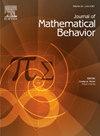Imagination as an embodied space for engaging with abstract algebra concepts
IF 1.7
Q3 EDUCATION & EDUCATIONAL RESEARCH
引用次数: 0
Abstract
The purpose of this research is to contribute to the literature at the intersection of imagination and the learning of abstract algebra through the lens of embodied cognition. We explored how imagination and perceptuomotor capacities can interact as two undergraduate students collaborated on an abstract algebra task. This task involved quotient group constructions in a research setting. Through our analysis we found that (a) imagination emerged as re-enactments of prior material and symbolic engagements, (b) different embodiments served a variety of interactive and supportive roles in imagining, and (c) joint embodiments with physical materials served to regulate and lift constraints on what can be imagined.
想象是参与抽象代数概念的具体空间
本研究的目的是通过具身认知的镜头,为想象与抽象代数学习的交叉点的文献做出贡献。我们以两名本科生合作完成一项抽象代数任务为例,探讨了想象力和感知运动能力是如何相互作用的。这项任务包括在研究环境中构建商群。通过我们的分析,我们发现(a)想象作为先前物质和符号约定的再现而出现,(b)不同的实施例在想象中起着各种互动和支持作用,(c)与物理材料的联合实施例用于调节和解除对可以想象的东西的限制。
本文章由计算机程序翻译,如有差异,请以英文原文为准。
求助全文
约1分钟内获得全文
求助全文
来源期刊

Journal of Mathematical Behavior
EDUCATION & EDUCATIONAL RESEARCH-
CiteScore
2.70
自引率
17.60%
发文量
69
期刊介绍:
The Journal of Mathematical Behavior solicits original research on the learning and teaching of mathematics. We are interested especially in basic research, research that aims to clarify, in detail and depth, how mathematical ideas develop in learners. Over three decades, our experience confirms a founding premise of this journal: that mathematical thinking, hence mathematics learning as a social enterprise, is special. It is special because mathematics is special, both logically and psychologically. Logically, through the way that mathematical ideas and methods have been built, refined and organized for centuries across a range of cultures; and psychologically, through the variety of ways people today, in many walks of life, make sense of mathematics, develop it, make it their own.
 求助内容:
求助内容: 应助结果提醒方式:
应助结果提醒方式:


